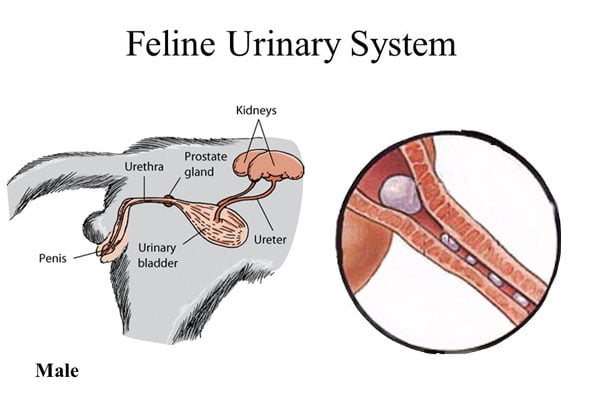
Internet surfers also search using similar terms such as:
- Why do male cats get blocked
- Why do male cats get crystals
Although crystals and a blockage are not strictly the same as an infection, blockages can result in infections. By “blocked bladders” I am assuming that cat owners are referring to a blockage in between the bladder and the exterior.
Sandy a regular visitor says:
“Since I started a FB page called CAT Advocate, I have people contacting me with questions. One common health issue in males is UTI. It’s unusual to have a male cat (fixed or not) that hasn’t suffered from UTI blockages.”
These contributions got me thinking. Feline lower urinary tract disease (FLUTD) encompasses feline UTIs (Urinary tract infections).
The anatomy of the male cat in the area of the lower urinary tract is different that of the female. The urethra – the tube which runs from the bladder to the exterior – is much narrower and longer in the male than the female.
“The anatomy of the male increases the likelihood of bladder obstruction” (Dr Debra Eldredge DVM et al)
It would seem that the added length and the narrowness of the male urethra makes is more susceptible to becoming blocked by a ‘plug’ of accumulated cells, crystals, debris and proteins or a small stone (a urolith) or a swelling of the urethra (due to an infection?).
This is the reason why males are more likely to have a urethral blockage which is one form of urinary tract disease.
Lower urinary tract problems are a major health concern of cat owners. There is a high rate (50-70%) of recurrence. FLUTD is also more common in older cats due to a mechanical problem or due to old age or inactivity.
A blocked urethra needs immediate veterinary care. I am not going to go over treatments of preventative actions. A vet can describe those.
However, I’d like to mention what Sandy said about preventative a treatment which I had never heard of before and neither have many vets. She said:
“A few years ago I was fortunate to speak with the owner of Vitality Science when my female cat had a UTI. He recommended UroCleanse, with D-Mannose to keep the urinary tract clear of bacteria. D-Mannose also helps people who experience frequent UTI. I sprinkle 1/4 tsp in each of my cat’s meals, as a preventative. I’ve mentioned it to vets, and none of them had heard of it. Not surprising!
Although it’s mainly a preventative, I’ve read that when used in larger quantities it has been used to treat UTI. But many times antibiotics are needed, so I wouldn’t rely on it as a treatment.”
I am putting this info out there. People can decide for themselves if they should act on it in consultation with their vet if she/he has heard about it.

A big contributor to blockages is dry cat food. It’s convenient for the owner, but it’s not what the cat evolved to eat. Cats evolved to get a lot of their fluid requirements from their prey so dry food needs additives to make cats thirsty so they drink from a water bowl. Even then, many cats don’t drink enough fluid.
With males that are prone to blockages, regardless of dietary management, surgery can be performed to widen the urethral open (guys – you may wince, because it involves removal of the penis, which is where the blockages tend to occur).
Some cats seem to prefer dry food over wet food and if that’s the case you need to go for a high quality dry food, which isn’t cheap. I use grain-free dry food because cats aren’t gramnivores.
When Go-Cat first came out, it was nicknamed “Gone Cat” by vets because it caused deadly blockages.
I am wincing….About dry cat food, the manufacturers make it so damn tasty my cat prefers it to the best wet cat food. I have to monitor him carefully.
I wonder if the manufacturer uses an engineered ingredient to make the cat think he must have that brand? High fructose corn syrup is put in human food for that reason.
Michael, Thank you for commenting on my post that included information on D-Mannose. A couple of things I forgot to mention is that it has a sweet flavor, so since cats don’t taste sweetness, there’s no problem with a cat rejecting it in their food. If only dry food is given in spite of evidence that it contributes to tooth decay, weight gain, and UTI, then it could be mixed with water, and given in a dropper syringe, in the cheek, not down the throat. (to prevent aspiration and choking)
When I mentioned to my son that my cat had a UTI, he also recommended D-Mannose, not aware that I had just found out about it from Vitality Science. He’s a personal trainer, and has recommended it to some his clients who are plagued with urinary infections. One woman used to get them several times a year, but since using D-Mannose, they have stopped completely. Interestingly, most of these are women, but it may be that men don’t talk about these things as much….
I look forward to readers comments, and thank you for spreading the word about this potentially life saving mineral.
Yes, my cat Buddy actually had the tendency to (and did) develop both kinds of crystals, and so the treatment to help prevent one made it easier to develop the other. What saved his life (preventing both from recurring ever again) was in switching to canned food, period. NO dry. He was also a mostly Maine Coon, which is a breed that tends to develop crystals more than other cats. After battling a few years with the problem, then switching the diet, he lived another 12 years without it recurring.